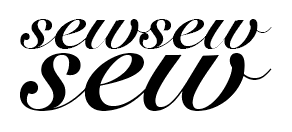Sewing a Sew House 7 Toaster Sweater - Hints and Tips
Share
My lovely mum has written this blog post about sewing your own Toaster Sweater...
The Sew House 7 Toaster Sweater #1 instructions are excellent, these are just some hints and tips which may help you to sew your own Toaster.
I used this beautiful Sparkly Glitter Sweatshirt in Old Rose to make this sweater. This fabric is 60 inches wide and I used 1.5 metres. I pre-washed the fabric at 30 degrees with an 800 spin (the same as I will use to wash the finished garment).
I made version 1 in a size medium with no alterations.
I folded the fabric selvedge to selvedge and this is the layout I used to cut out the pattern:

I folded the bottom band in half and placed that on the fold to cut. The pattern piece for the back is face down on the fabric to allow it to be placed on the fold. As I wanted to be able to see the grainline and pattern markings, I have marked these on the back of the pattern by holding the pattern piece up to a window and tracing through.

I pinned and cut out using scissors, I like to cut the notches outwards from the pattern piece rather than into the seam allowance. To remind me to cut them I highlight the markings on the pattern piece.

I used my overlocker and sewing machine to make this garment.
On my overlocker the settings I used for a 4 thread overlock are:
- Stitch width 7. I moved the cutting blade further away from the stitching line as this fabric was thicker and it makes it easier to press and topstitch in place.
- Stitch length 2.5
- I also reduced the presser foot pressure to 4 as the fabric is quite thick, this helped the fabric to feed through the machine.
- I tested these settings on some scraps of the same fabric before starting to stitch my pieces together.
Firstly, the raglan seams are stitched. I pinned and marked the seam allowance using a frixion pen at 5/8ths of an inch.

The marks were then lined up with the left- hand needle on my overlocker and stitched

Once all 4 raglan seams were stitched and pressed with the seams towards the body, I topstitched them using my sewing machine and a 4mm stretch twin needle which straddled the seam perfectly.

On my Pfaff sewing machine:
- In the settings menu I selected twin needle sewing and then selected the size of the gap between the needles (which for my needle was 4mm)
- I also lowered the presser foot pressure to 5 (the default is 6.5)
- I increased my stitch length to 3.5
The foot I used has a red mark showing where the centre line is. I lined this mark up with the seam line and stitched. I didn’t backstitch at the beginning or end as the edges were going to be enclosed in another seam.
I repeated this for all 4 raglan seams
I divided the neck into four quarters and marked with pins ready for sewing the collar on:

The collar was next. The instructions tell you to fold the T Neck in half so that the short ends meet and stitch using an overlocker or a double stitch. I personally always stitch these seams (as well as band and cuff seams) on my sewing machine with a straight stitch, the seams are not under stress to necessitate a stretch stitch. I then pressed the seam open which reduces bulk in the seam. (If I had used my overlocker the seam would be pressed to one side creating bulk).


Once the seam had been pressed open I folded the neck band in half wrong sides together and pressed. I then divided the collar into four, the centre front has a notch already and the seam is the centre back. I added the two extra marks by matching the centre front with the centre back and pinning at the fold at either end of the neckband
When I pinned the collar onto the neck I matched the seam with the centre back, the front notch on the collar matched the notch on the front body and the pins other marks will match the pins I placed on the neck opening. By dividing the neckband into four it ensures that the collar sits neatly in the neck opening.
Once stitched on I pressed the seam towards the body and top stitched using the twin needle.
After the side and sleeve seams had been stitched, the band and cuffs were stitched on.

I prepared those in the same way as the collar, stitching the seam on my sewing machine and pressing open to reduce bulk. The band was then folded in half and pressed.

I divided the bottom band and the bottom of the garment into four and then pinned in place matching the marks. The seam line on the bottom band was matched to the left side seam.
After pressing the seam towards the body, I topstitched the seam using the twin needle. The cuffs were stitched on and pressed but not topstitched as the cuff would not fit over the free arm of my machine.
One final press and it was finished. I can see myself making more of these sweaters, a lovely straightforward pattern with fantastic instructions.

We have this sweatshirt fabric in three colourways; Pale Pink, Oatmeal and Mustard . They are also our Fabric of the week and are reduced until next Friday 31/1/2020



